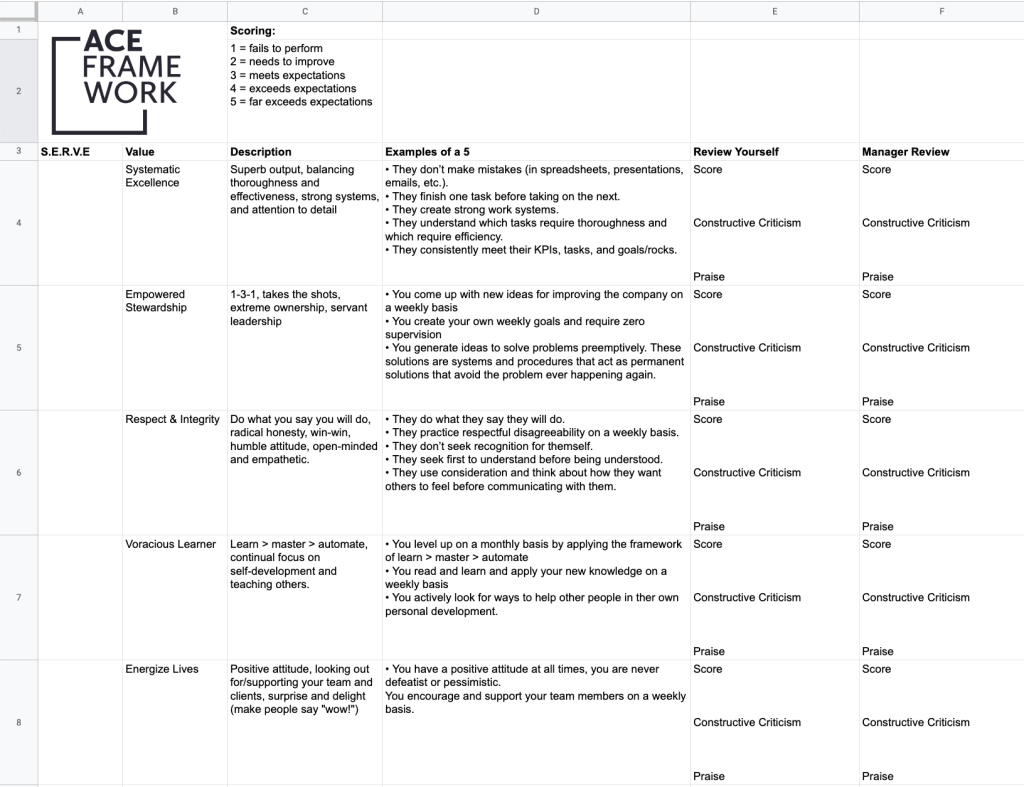- Why performance reviews should be conducted each quarter.
- Why performance reviews are necessary.
- How performance reviews can improve a business’ bottom line.
- An example template of a performance review.
In today’s economic climate, it’s a reality that finding good employees is hard. There is immense competition from companies looking for talented and hardworking people to fill out their org charts.
Once you do manage to attract the right people, you must ensure that all of your employees are working to the best of their ability, feel empowered in their positions, and have an innate understanding of their job description.
Regular performance reviews are integral to ensure that everyone is progressing in their careers at the right pace. These reviews are one of the most powerful tools in the managerial toolbelt. However, they can inspire a range of emotions in employees. Some people offer an opportunity to discuss their accomplishments and receive praise, while others find them to be nerve-wracking experiences that lead them to question their abilities.
Yet, performance reviews are vitally necessary to ensure a company succeeds. After all, a business is little more than the sum of the people who work there. When individuals improve, the company yields immense benefits.
Importantly, these reviews should be conducted quarterly. Anything less than that would simply be a lagging indicator of professional performance and would not be useful for correcting issues.
7 Reasons For Performance Reviews

1. Improve Employee Performance
The most obvious benefit of regular reviews is that they provide an opportunity to improve the business's overall performance. As we mentioned, when individuals improve, it benefits the entire company.
Taking time to look over the work your staff has done over the last quarter provides an opportunity to identify areas needing more attention or resources. If you can identify a problem, analyze it, and find a solution, you can often find savings by improving efficiencies.
Managers can use these opportunities to help employees set benchmarks to measure progress. If you identify serious problems, you may need to put the worker on probation, which can eventually lead to a Performance Improvement Plan (PIP).
2. Identify Opportunities For Advancement
If an open position in your org chart needs to be filled, the right candidate is often already working for you. Regular performance reviews allow you an opportunity to identify staff that may be the right fit for various positions within the business. This can help you decide whether you need to advertise externally for the role from the beginning or whether you might consider promoting someone from within the company, setting off your succession plan.
Indeed, employees that are promoted from within usually save the company money and perform better than external hires. A study from SAGE Journals showed that external hires tend to perform significantly lower on performance reviews during their first two years than internal workers promoted to similar positions. Those external hires were also more likely to leave the company, despite earning salaries that cost employers 18 to 20 percent more than those who were internally promoted, according to the study.
3. Improve Employee Engagement
The process allows staff a greater understanding of how their role contributes to the overall goals of the company.
Performance reviews should also be seen as an opportunity to help your employees. They offer an excellent opportunity to provide regular feedback, which has been shown to increase overall employee engagement. The process allows staff a greater understanding of how their role contributes to the company's overall goals, which will often increase their investment in the outcome of those goals.
And that can have great benefits for the company. According to an article from Gallup, there is a strong correlation between employee engagement and the quality of sales, service, retention, safety, and profit.
4. Improve Loyalty
These reviews also allow managers an opportunity to speak in-depth with their team, improving the overall relationship between manager and employee. Managers can praise good performance and reward hard work but also listen to complaints, answer questions, and quell concerns that employees might have.
5. Instill Company Values
Regular meetings also allow managers to reinforce the company’s overall values. Performance reviews should be tied to the company’s core values (as we’ll talk about further in this article), allowing managers to discuss the company’s values and ensure workers understand them.
6. Identify Training or Onboarding Needs
New employees will need to undergo onboarding and training when they are first hired, but the learning doesn’t stop just because the training has been completed. Employees should continue to learn on the job. This is doubly true if the company adopts new processes, implements new systems, or decides on a different strategy. Most workers will need additional instruction at some point during their employment.
If, during the regular performance reviews, you identify that multiple staff are struggling with the same concepts or with the same part of the job, it likely indicates that there is a flaw in your training or onboarding processes
7. Legal Protection For The Company
If an employee isn’t succeeding, you may need to implement a Performance Improvement Plan to help them get on track. But before a PIP is implemented, you should bring up any concerns during their regular performance review.
This will be an important document if you need to fire the employee and they decide to sue. If you can document your concerns and that those concerns were communicated to the employee in an official capacity, you can protect the company from harmful litigation.
How We Do Performance Reviews
At Acquira, we prefer a form of 360-degree performance review that ties work performance squarely to our core values. These reviews are performed quarterly and only after you have defined your core values.
The employee evaluates his or her own performance in light of Acquira’s core values and is, in turn, evaluated by their manager and, in some cases, the co-workers with whom they work most closely. However, it’s important to note that employees do not see their colleagues’ evaluations.
If an employee’s job is customer-facing, part of their review would include customer satisfaction surveys given to their manager before the review.
Acquira’s Performance Review Template
The employees’ work is rated on a scale of 1-5:
1 – Fails to perform
2 – Needs to improve
3 – Meets expectations
4 – Exceeds
5 – Far exceeds
That list is applied to each of our core values, and a ranking is assigned for how well the employee and their work align with that value. At Acquira, we created the SERVE acronym to exemplify those values.

Each core value is accompanied by examples of behavior that we believe demonstrate a full understanding and demonstration of that value. For example, for someone to receive a 4 for Systematic Excellence, they would need to ensure:
- They don’t make mistakes (in spreadsheets, presentations, emails, etc.).
- They finish one task before taking on the next.
- They create strong work systems.
- They understand which tasks require thoroughness and which require efficiency.
- They consistently meet their KPIs, tasks, and goals/rocks.
If they were to receive a 4 on their performance review for Respect & Integrity (The “R” in SERVE), they would need to ensure that:
- They do what they say they will do.
- They practice respectful disagreeability weekly.
- They don’t seek recognition for themself.
- They seek first to understand before being understood.
- They use consideration and think about how they want others to feel before communicating with them.
First, the employee is asked to rate themselves on each core value, and their manager rates them on those core values, followed by their colleagues (if applicable). The ratings are justified by filling out sections labeled ‘Constructive Criticism’ and ‘Praise.’ The entries made here must always reference the employee's activities and how well they have performed them.

After the rating section is completed, there are several questions that the employee will then fill out:
- What is one thing you have accomplished since the last review cycle that you are proud of?
- What is the most important thing you can improve on between now and the next review?
- Where are you now with your various roles/tasks in the company?
- List your various tasks and responsibilities in the table below.
- For each task, indicate whether you are Learning, Mastering, Managing/Automated.
- Write any applicable notes that come to mind. For instance, do you enjoy the task? Do you dislike it? Have you mastered the task, and are you ready to delegate it?
Learning: You’re still seeing major performance gains
Mastering: You’re hitting your performance peak and you are improving upon existing processes.
Managing/Automated: You’ve already delegated the task to someone else and you are managing them, or you’ve automated the task through software or systems.The Follow Up

Once the employee, manager, and colleagues have each assessed the employee, he or she meets with the manager, often remotely via video chat, for a one-hour session to review and discuss the results.
The manager should always start by praising and recognizing any and all good work. Doing this creates empathy and opens the employee's mind to hear about areas of opportunity or deficiencies they need to improve. They should also make sure to point out any behavior that particularly exemplified a core value or where they did the opposite.
Remember, these are quarterly reviews to ensure information is gathered in a timely manner. Feedback received annually is a lagging indicator, and any insights won’t help encourage or improve performance.
The manager can then ask the employee a list of questions to see where the employee is in their career progression and gather their thoughts on the company as a whole. These questions can be used to spark conversation and generate valuable feedback for the company:
- What do you think is the most valuable thing about your work?
- What would you like to learn more about construction?
- What has been your level of progress since you have been with us?
- What are two goals you want to achieve by the next review?
- What has been your progress on your two goals from the last review?
- What do you like most about the company?
- What do you like least about the company, and how do you think that can be improved?
What Do You Do After A Performance Review?
Following the performance assessment, both the manager and employee will be loaded with new information. There are new goals to achieve and metrics to measure. Perhaps changes need to be made.
The employee should know that these goals are not overnight requests. They are something that can be chipped away at or strived for. The most important thing moving forward is that they continue to try to track their own job performance.
For the manager, any documents should be filed away so they can be referred to ahead of the employee’s next performance review. Any company feedback should be shared amongst the leadership team so they can identify potential organizational problems and make plans to fix them.
Conclusion
One of the most important things you can do as a business owner is to help your employees improve at their jobs. It shows respect for the worker and that you believe in their abilities. Even if they are faltering, reviews should demonstrate your faith in their ability to improve.
Reviews should be conducted quarterly to ensure individuals have time to learn and improve their behavior if necessary. Managers should look for exemplary behavior that they can share with other workers to help everyone improve.
Almost everyone who has ever worked at a job has a story about a particularly great or a particularly awful performance review experience. We would love it if you would share your stories in the comments below.
Portions of the above article were taken from our ACE Framework. The Framework is available to anyone who closes a deal through the Accelerator Program. To learn more about the program and how Acquira can help you on your acquisition journey, schedule a call with us today.
Key Takeaways
- Quarterly reviews serve as leading indicators, while annual reviews are lagging indicators.
- Professional performance reviews should help the company as much as they help the employee.
- If an employee isn’t succeeding, you may need to implement a Performance Improvement Plan to help them get on track.
- All documents associated with a performance review should be kept on file.
- Employees should review themselves, as well as their manager and (potentially) their colleagues.
Acquira specializes in seamless business succession and acquisition. We guide entrepreneurs in acquiring businesses and investing in their growth and success. Our focus is on creating a lasting, positive impact for owners, employees, and the community through each transition.



